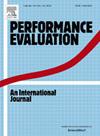The Multiserver Job Queuing Model with big and small jobs: Stability in the case of infinite servers
IF 0.8
4区 计算机科学
Q4 COMPUTER SCIENCE, HARDWARE & ARCHITECTURE
引用次数: 0
Abstract
The Multiserver Job Queuing Model (MJQM) is a queuing system that plays a key role in the study of the dynamics of resource allocation in data centers. The MJQM comprises a waiting line with infinite capacity and a large number of servers. In this paper, we look at the limiting case in which the number of servers is infinite. Jobs are termed “multiserver” because each one is characterized by a resource demand in terms of number of simultaneously used servers and by a service duration. Job classes are defined by collecting all jobs that require the same number of servers. Job service times are independent and identically distributed random variables whose distributions depend on the class of the job. We consider the case of only two job classes: “small” jobs use a fixed number of servers, while “big” jobs use all servers in the system. The service discipline is First-In First-Out (FIFO). This means that if the job at the Head-of-Line (HOL) cannot enter service because the number of free servers is not sufficient to meet the job requirement, it blocks all subsequent jobs, even if there are sufficient free servers for them. Despite its importance, only few results exist for the MJQM, whose analysis is challenging, especially because the MJQM is not work-conserving. This implies that even the stability region of the MJQM is known only in special cases. In a previous work, we obtained a closed-form stability condition for MJQM with big and small jobs under the assumption of exponentially distributed service times for small jobs. In this paper, we compute the stability condition of MJQM with an infinite number of servers processing big and small jobs, considering different distributions of the service times of small jobs. Simulations are used to support the analytical results and to investigate the impact of service time distributions on the average job waiting time before saturation.
具有大小作业的多服务器作业排队模型:无限服务器情况下的稳定性
多服务器作业排队模型(MJQM)是一种排队系统,在数据中心资源分配动态研究中起着关键作用。MJQM由无限容量的等待队列和大量服务器组成。在本文中,我们研究了服务器数量为无穷大的极限情况。作业被称为“多服务器”,因为每个作业都以同时使用的服务器数量和服务持续时间的资源需求为特征。作业类是通过收集需要相同数量服务器的所有作业来定义的。作业服务时间是独立且同分布的随机变量,其分布取决于作业的类别。我们只考虑两个作业类别的情况:“小”作业使用固定数量的服务器,而“大”作业使用系统中的所有服务器。服务原则是先进先出(FIFO)。这意味着,如果由于空闲服务器的数量不足以满足作业需求,位于排队头(HOL)的作业无法进入服务,则它会阻塞所有后续作业,即使有足够的空闲服务器可供它们使用。尽管MJQM很重要,但只有很少的结果存在于MJQM中,其分析具有挑战性,特别是因为MJQM不节省工作。这意味着即使是MJQM的稳定区域也只有在特殊情况下才知道。在前人的工作中,我们在小作业服务时间呈指数分布的假设下,得到了具有大小作业的MJQM的闭型稳定性条件。本文考虑小任务服务时间的不同分布,计算了无限多个服务器处理大小任务时MJQM的稳定性条件。模拟用于支持分析结果,并研究服务时间分布对饱和前平均作业等待时间的影响。
本文章由计算机程序翻译,如有差异,请以英文原文为准。
求助全文
约1分钟内获得全文
求助全文
来源期刊

Performance Evaluation
工程技术-计算机:理论方法
CiteScore
3.10
自引率
0.00%
发文量
20
审稿时长
24 days
期刊介绍:
Performance Evaluation functions as a leading journal in the area of modeling, measurement, and evaluation of performance aspects of computing and communication systems. As such, it aims to present a balanced and complete view of the entire Performance Evaluation profession. Hence, the journal is interested in papers that focus on one or more of the following dimensions:
-Define new performance evaluation tools, including measurement and monitoring tools as well as modeling and analytic techniques
-Provide new insights into the performance of computing and communication systems
-Introduce new application areas where performance evaluation tools can play an important role and creative new uses for performance evaluation tools.
More specifically, common application areas of interest include the performance of:
-Resource allocation and control methods and algorithms (e.g. routing and flow control in networks, bandwidth allocation, processor scheduling, memory management)
-System architecture, design and implementation
-Cognitive radio
-VANETs
-Social networks and media
-Energy efficient ICT
-Energy harvesting
-Data centers
-Data centric networks
-System reliability
-System tuning and capacity planning
-Wireless and sensor networks
-Autonomic and self-organizing systems
-Embedded systems
-Network science
 求助内容:
求助内容: 应助结果提醒方式:
应助结果提醒方式:


